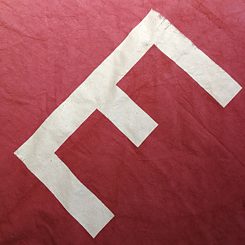Typography and Screen Printing
Module 3
School // Workshop // Age 14–18 // 3 hours // 3–4 lessons
Fabric // screen printing
Printing and advertising workshop // typography // graphic design // Herbert Bayer
 Alexia Manzano | CC BY-NC-SA 4.0
YOU WILL NEED:
Alexia Manzano | CC BY-NC-SA 4.0
YOU WILL NEED:
- Squared paper
- pencils
- marker pens
- scissors
- fabric bags
- fabrics
- screen printing frames (A3, 1 per group)
- squeegees (1 per group)
- fabric ink for screen printing
- spatulas
- sponge
- adhesive foil
- paper tape
- cardboard as base
INSTRUCTIONS
This module provides an introduction to the development of typography at the Bauhaus in Weimar (under László Moholy-Nagy and Wassily Kandinsky) and Dessau (under Herbert Bayer and others). At the same time, participants learn one of the most important basic printing techniques, screen printing. First of all, examples of various designs are examined in books and websites, including the graphic devices and basic geometrical forms used in the work of Herbert Bayer and Josef Albers. Subsequently participants prepare their own designs and print them onto fabric bags or items of clothing (which they have brought with them) using a simplified screen-printing method.Step 1: With the examples from Herbert Bayer and Josef Albers in mind, the participants work in small groups of four or five to design letters and graphic elements based on the basic geometrical forms (square, circle and triangle).
Step 2: The participants share their designs and agree on a letter, word or collage on which they will work together.
Step 3: The designs on paper are transferred to the adhesive foil, from which the templates are carefully cut using craft knives and scissors. If two or more colours are to be used, the printing must be done in several stages (this variant is best suited for more practised or older participants).
Step 4: Now the adhesive foil templates are attached to the screen. This works best if two participants press the frame onto the base (cardboard) to keep it motionless while two others smooth the foil onto the screen (evenly and without bubbles or creases). The outside edges are taped off using paper tape.
Step 5: The fabric to be printed is placed on the base and smoothed out. Then the screen is positioned with the template at the required position. Two or three participants hold the screen still from different sides and press it gently onto the fabric. Two other participants apply ink to one of the longer sides of the screen using a spatula.
Step 6: Now printing can begin. One participant holds the squeegee at a slight angle and draws it to the other side of the screen, causing the ink to be pressed evenly through the screen. A little pressure must be applied. Then the squeegee is lifted and the ink pushed back again (angle the squeegee as before).
Step 7: Now the screen is carefully lifted (without shifting it on the fabric). The motif should now be printed evenly on the fabric.
Step 8: The procedure can now be repeated for another piece of fabric. Ink will need to be added as necessary. After the last print any surplus ink is returned to the container.
Step 9: Wash the screen using warm water before the ink has time to dry. The screen should be allowed to dry properly before further printing. If a second colour is required, the procedure is repeated with a second template. Ideally the fabric should be allowed to dry first, so the second colour is best applied the next day (or at least after a break).
